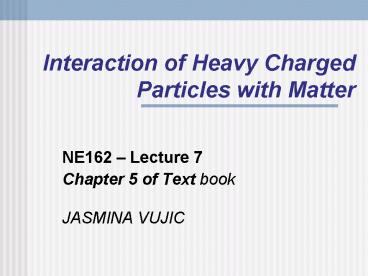Interaction of Heavy Charged Particles with Matter - PowerPoint PPT Presentation
1 / 23
Title:
Interaction of Heavy Charged Particles with Matter
Description:
Can transfer only a small fraction of its energy in a single collision with an electron. ... is the probability of collision per unit path length, and Qave ... – PowerPoint PPT presentation
Number of Views:861
Avg rating:3.0/5.0
Title: Interaction of Heavy Charged Particles with Matter
1
Interaction of Heavy ChargedParticles with Matter
- NE162 Lecture 7
- Chapter 5 of Text book
- JASMINA VUJIC
2
Interaction of heavy charged particles with matter
- Heavy charged particles all charged particles
other than the electron or positron - Include muons (M 207 me), pions (M 270 me),
kaons (M 967 me), protons (M 1836 me), alpha
particles, deuterons, tritons, fission fragments,
other heavy ions - Energy-Loss Mechanisms
- (a) collisions with electrons (b) radiative
- Ionization of atoms
- Excitation of atoms
3
Sketch of alpha particles paths in a medium
- Can transfer only a small fraction of its energy
in a single collision with an electron. Thus,
heavy charged particles - travel almost in straight lines (straight line
trajectory) - lose energy almost continuously in small amounts
- have a very small range
4
Ionization
http//en.wikibooks.org/wiki/Basic_Physics_of_Nucl
ear_Medicine/Interaction_of_Radiation_with_Matter
5
Maximum Energy Transfer in a Single Collision
Before
After
Conservation of total kinetic energy and momentum
6
Maximum Energy Transfer in a Single Collision
- From the first two equations we obtain
- V1 (M-m)/(Mm) V
- and the maximum energy transfer is given by
- Qmax ½ MV² - ½ MV1² E4mM/(Mm)²
E mV2/2, the initial kinetic energy of incident
particle
7
Maximum Energy Transfer in a Single Collision
- For incoming electron
- Qmax E, if M me
- For muon
- Qmax 4me(207 me)/(208 me)2E
- Qmax 0.0192 E
8
Maximum Energy Transfer in a Single Collision
9
STOPPING POWER
- Stopping power is defined as the average energy
loss of a charged particle per unit path length - where µ is the probability of collision per unit
path length, and Qave is the average energy loss
per collision. - The mass stopping power is given as
10
Bethe Formula for stopping power
- Where
- ko 8.99 x 109 N m² C-1
- Z atomic number of heavy particle e - electron
charge - n number of electron per unit volume m
electron rest mass - c speed of light in vacuum
- ß V/c speed of the particle relative to c
- I mean excitation energy of the medium
11
MEAN EXCITATION ENERGY OF THE MEDIUM
- For a compound or mixture, the stopping power can
be calculated by simpling adding the separate
contributions from the individual constituent
elements - where i corresponds to an individual element.
12
Stopping power of water for various heavy charged
particles
13
Stopping Power vs. Energy for protons, deuterons
and alpha particles in Si and Ge
http//www.ortec-online.com/detectors/review_physi
cs/interaction.htm
14
Bragg Curve
- A curve showing the average number of ions per
unit distance along ( or a specific ionization) a
beam of initially monoenergetic ionizing
particles, usually alpha particles, passing
through a gas. Also known as a Bragg ionization
curve.
15
Energy Deposition of Alpha particles
- Specific ionization - SI
- SI (dE/dx)/EI
- Number of ion pairs per unit path length
- EI,air 36 eV/ip
- EI,tissue 22 eV/ip
16
RANGE
- The range of a charged particle is the distance
it travels before coming to rest. - For a particles in air, the following approximate
empirical relations exist
17
Range of alpha particles
18
Range Measurement
http//www.med.harvard.edu/JPNM/physics/didactics/
physics/charged/lect.html
19
RANGE
- The ranges of two heavy particles with the same
initial speed could be determined from the
following ratio - The range of other charged particles in terms of
proton range - For example, the range of alpha particle from
214Po decay (E7.69 MeV) is - in air about 6cm
- in tissue about 0.007 cm
20
Ranges
http//www.ortec-online.com/detectors/review_physi
cs/interaction.htm
21
Table 5.3 Mass stopping power and ranges for
protons in water
22
Figure 5.7 Ranges of p, ?, electrons in water,
muscle, bone, lead
23
Figure 5.8 Ranges of p, ?, electrons in air































